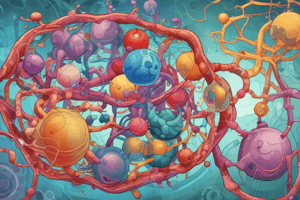Podcast
Questions and Answers
What is the primary function of carbohydrates in living organisms?
What is the primary function of carbohydrates in living organisms?
- Energy storage and structural components (correct)
- Hormonal signaling
- Transport of genetic information
- Catalysis of biochemical reactions
Which level of protein structure involves the sequence of amino acids?
Which level of protein structure involves the sequence of amino acids?
- Secondary structure
- Tertiary structure
- Quaternary structure
- Primary structure (correct)
Which statement accurately describes nucleic acids?
Which statement accurately describes nucleic acids?
- They are composed of amino acids.
- They make up the structure of cell membranes.
- They are primarily involved in energy storage.
- They store and transfer genetic information. (correct)
What is the role of ATP in metabolism?
What is the role of ATP in metabolism?
What characterizes the active site of an enzyme?
What characterizes the active site of an enzyme?
Which process involves the conversion of glucose into pyruvate?
Which process involves the conversion of glucose into pyruvate?
What is the function of cofactors in enzymatic reactions?
What is the function of cofactors in enzymatic reactions?
What is produced during the Krebs Cycle apart from ATP?
What is produced during the Krebs Cycle apart from ATP?
Flashcards are hidden until you start studying
Study Notes
Overview of Biochemistry
- Biochemistry is the study of chemical processes within and related to living organisms.
- It combines principles of biology and chemistry to understand cellular functions and metabolism.
Major Classes of Biomolecules
-
Carbohydrates
- Composed of carbon, hydrogen, and oxygen.
- Function: Energy storage (e.g., glycogen, starch) and structural components (e.g., cellulose).
- Types: Monosaccharides (simple sugars), Disaccharides, Polysaccharides.
-
Proteins
- Made of amino acids linked by peptide bonds.
- Function: Catalysis (enzymes), structural (collagen), transport (hemoglobin), signaling (hormones).
- Levels of Structure:
- Primary: Sequence of amino acids.
- Secondary: Alpha helices and beta sheets.
- Tertiary: 3D structure.
- Quaternary: Multiple polypeptide chains.
-
Lipids
- Diverse group including fats, oils, waxes, and sterols.
- Function: Energy storage, membrane structure (phospholipids), signaling (steroids).
- Saturated vs. Unsaturated fatty acids.
-
Nucleic Acids
- DNA and RNA, composed of nucleotides.
- Function: Genetic information storage (DNA) and transfer (RNA).
- Structure: Double helix (DNA) and single-stranded (RNA).
Metabolism
- Metabolism consists of:
- Catabolism: Breakdown of molecules for energy.
- Anabolism: Synthesis of complex molecules from simpler ones.
- ATP (Adenosine Triphosphate) is the primary energy currency of the cell.
Enzymes
- Biological catalysts that speed up chemical reactions.
- Characteristics:
- Specificity: Each enzyme works on a particular substrate.
- Active site: Region where substrate binds.
- Cofactors: Non-protein molecules that assist enzyme function.
- Enzyme kinetics: Refers to the rate of enzymatic reactions and the effects of substrate concentration, enzyme concentration, and inhibitors.
Key Processes
-
Glycolysis
- First step in cellular respiration.
- Converts glucose into pyruvate, producing ATP and NADH.
-
Krebs Cycle (Citric Acid Cycle)
- Occurs in the mitochondria.
- Processes acetyl-CoA to produce NADH, FADH2, and ATP; releases CO2.
-
Electron Transport Chain
- Series of proteins in the inner mitochondrial membrane.
- Uses electrons from NADH and FADH2 to create a proton gradient, ultimately producing ATP.
Cellular Signaling
- Biochemical signals (hormones, neurotransmitters) trigger cellular responses.
- Signal transduction pathways involve receptor proteins, secondary messengers, and cascade effects leading to specific cellular responses.
Techniques in Biochemistry
- Chromatography: Separation of biomolecules.
- Gel electrophoresis: Separation of macromolecules based on size and charge.
- Western blotting: Detection of specific proteins.
- Mass spectrometry: Identification and quantification of biomolecules.
Importance of Biochemistry
- Understanding diseases and developing treatments.
- Biotechnological applications (e.g., genetic engineering).
- Studying metabolic pathways in health and disease.
Overview of Biochemistry
- Biochemistry studies chemical processes within and relating to living organisms.
- It combines biology and chemistry to understand cell functions and metabolism.
Major Classes of Biomolecules
- Carbohydrates are composed of carbon, hydrogen, and oxygen.
- They function in energy storage (glycogen, starch) and structural components (cellulose).
- Examples include monosaccharides (simple sugars), disaccharides, and polysaccharides.
- Proteins are made up of amino acids linked by peptide bonds.
- They perform various functions like catalysis (enzymes), structural support (collagen), transport (hemoglobin), and signaling (hormones).
- Proteins have different levels of structure:
- Primary Structure: Sequence of amino acids.
- Secondary Structure: Alpha helices and beta sheets.
- Tertiary Structure: 3D structure.
- Quaternary Structure: Multiple polypeptide chains.
- Lipids are a diverse group including fats, oils, waxes, and sterols.
- Function in energy storage, membrane structure (phospholipids), and signaling (steroids).
- Divided into saturated and unsaturated fatty acids based on their structure.
- Nucleic Acids include DNA and RNA, composed of nucleotides.
- Function in genetic information storage (DNA) and transfer (RNA).
- DNA has a double helix structure while RNA is single-stranded.
Metabolism
- Metabolism encompasses catabolism and anabolism.
- Catabolism: Breakdown of molecules for energy.
- Anabolism: Synthesis of complex molecules from simpler ones.
- ATP (Adenosine Triphosphate) is the primary energy currency of the cell.
Enzymes
- Biological catalysts that speed up chemical reactions.
- Characterized by:
- Specificity: Each enzyme works on a particular substrate.
- Active site: The region where the substrate binds.
- Cofactors: Non-protein molecules aiding enzyme function.
- Enzyme kinetics: Describes the rate of enzymatic reactions and factors affecting it like substrate concentration, enzyme concentration, and inhibitors.
Key Processes
- Glycolysis: The first step in cellular respiration.
- Converts glucose into pyruvate, producing ATP and NADH.
- Krebs Cycle (Citric Acid Cycle): Occurs in the mitochondria.
- Processes acetyl-CoA to produce NADH, FADH2, and ATP; releases CO2.
- Electron Transport Chain: A series of proteins in the inner mitochondrial membrane.
- Uses electrons from NADH and FADH2 to create a proton gradient, ultimately producing ATP.
Cellular Signaling
- Biochemical signals (hormones, neurotransmitters) trigger cellular responses.
- Signal transduction pathways involve receptor proteins, secondary messengers, and cascade effects leading to specific cellular responses.
Techniques in Biochemistry
- Chromatography: Separation of biomolecules.
- Gel electrophoresis: Separation of macromolecules based on size and charge.
- Western blotting: Detection of specific proteins.
- Mass spectrometry: Identification and quantification of biomolecules.
Importance of Biochemistry
- Understanding diseases and developing treatments.
- Biotechnological applications (like genetic engineering).
- Studying metabolic pathways in health and disease.
Studying That Suits You
Use AI to generate personalized quizzes and flashcards to suit your learning preferences.




